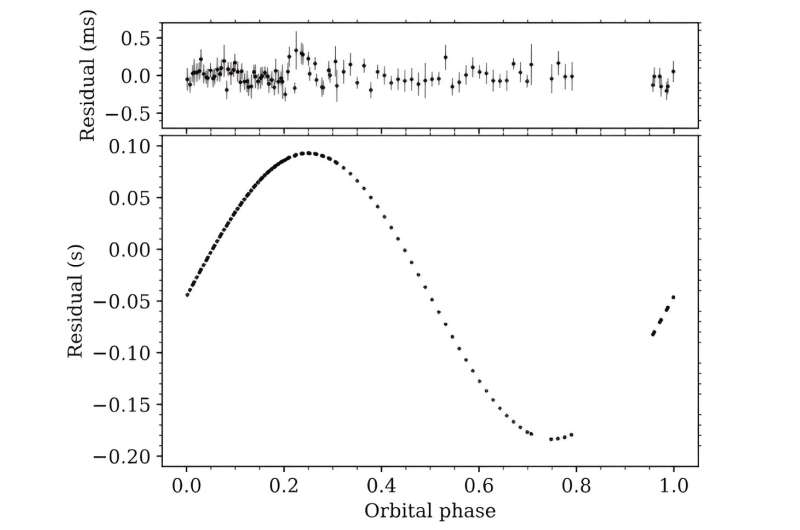The top panel shows the pulsar timing residuals as a function of orbital phase for PSR J17442946. The bottom panel assumes the binary major semi-axis is zero to demonstrate the effect of accompanying objects. Image source: Lower et al., 2024.
Astronomers at the Australian National Telescope Facility (ATNF) report the discovery of a new millisecond pulsar in the “Snake” – the radio filament at the center of the Milky Way. This is the first millisecond pulsar detected in the center of our galaxy. The findings are detailed in a paper published on a preprint server on April 13 arXiv.
Pulsars are highly magnetized rotating neutron stars that emit beams of electromagnetic radiation. The fastest rotating pulsars, whose rotation period is less than 30 milliseconds, are called millisecond pulsars (MSP). Astronomers believe they form in binary star systems when the initially more massive component becomes a neutron star and then spins up due to the accretion of material from the secondary star.
Now, a team of astronomers led by ATNF’s Marcus E. Lower has detected a new MSP using the Murriyang Ultra-Wideband Low (UWL) receiving system at Australia’s 64-meter Parkes radio telescope. They studied the recently discovered radio point source in G359.10.2 (designated G359.131420.2000), known as the “snake” of the most prominent radio filament at the center of the Milky Way.
The researchers wrote in the paper: “We used the Murriyang Ultra-Wideband Low Wave (UWL) receiving system to conduct the target of opportunity observation of G359.131420.2000 (project code PX130) on March 25, 2024.”
As a result, the team discovered a pulsar with a rotation period of 8.39 milliseconds. The newly discovered MSP has a dispersion measurement of approximately 673.7 pc/cm3received designation PSR J17442946.
According to research, PSR J17442946 is about 27,400 light-years away from us and has a radio luminosity of 30 mJy kpc2. The flux density of PSR J17442946 at 4 GHz matches that of G359.131420.2000, and astronomers believe that the newly discovered pulsar may be powering this source.
Observations found that PSR J17442946 is a binary star system with an orbital period of about 4.8 hours. The companion is estimated to have a mass of at least 0.05 solar masses.
The researchers noted that PSR J17442946 may be related to snakes. If confirmed, this would suggest that pulsars may be responsible for illuminating the radio filaments at the center of the Milky Way.
Summarizing these results, the authors of the paper emphasize that the discovery of millisecond pulsars so close to the center of the Milky Way gives hope that many MSPs have not yet been discovered there. However, high-frequency surveys are needed to confirm this.
The scientists concluded: “Therefore, future surveys of the entire galactic central region at 3 GHz and above will be necessary. The detection of a large number of MSPs will support the idea that the Fermi GeV excess in this region is generated by such a population.”
More information:
Marcus E. Lower et al., A Snake’s Heartbeat? Millisecond pulsar binary in the galactic central radio filament G359.10.2, arXiv (2024). DOI: 10.48550/arxiv.2404.09098
Journal information:
arXiv
2024 Science X Network
citation: Pulsating Snake: First millisecond pulsar discovered at the center of the Milky Way (2024, April 22) Retrieved April 22, 2024 from https://phys.org/news/2024-04-pulsating-snake -millisecond-pulsar-gactic.html
This document is protected by copyright. No part may be reproduced without written permission except in the interests of fair dealing for private study or research purposes. Content is for reference only.
#Pulsating #Snake #millisecond #pulsar #discovered #center #Milky
Image Source : phys.org
